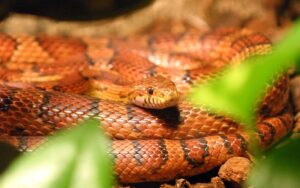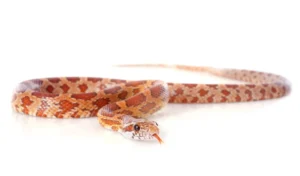Can corn snakes swim? Among the many fascinating aspects of corn snakes, their ability to navigate different terrains and environments raises interesting questions about their adaptability. While primarily terrestrial, corn snakes occasionally encounter water in their natural habitats.
Understanding their swimming capabilities sheds light on their survival strategies and behavioral flexibility. This exploration into whether corn snakes can swim unveils another layer of their intriguing biology and habitat interactions.
Corn Snakes and Water

Corn snakes, despite being primarily terrestrial, can navigate water when necessary. In their natural habitats, which include forests, grasslands, and farmlands across southeastern and central United States, encountering bodies of water such as streams, ponds, or marshes is not uncommon.
While they do not thrive in aquatic environments like amphibians or aquatic turtles, corn snakes are capable of swimming when they need to cross water obstacles or find refuge during floods. Their ability to swim, albeit not their preferred mode of movement, showcases their adaptability and survival instincts in diverse ecological settings.
Can corn snakes swim?
Corn snakes, like many other terrestrial snakes, have the ability to swim when they encounter water. While they are not aquatic by nature and typically prefer dry habitats, they can manage short swims when needed.
Here are some points to explain further:
- Adaptations for Swimming: Corn snakes have a streamlined body shape that allows them to move through water relatively efficiently. Their scales also provide some waterproofing, which helps them stay buoyant.
- Natural Habitats: In the wild, corn snakes inhabit a variety of environments ranging from forests and fields to rocky hillsides. Occasionally, they may come across streams, ponds, or other bodies of water. If they need to cross or explore these areas, they can swim to navigate through them.
- Behavior in Water: When corn snakes swim, they use a lateral undulation movement similar to how they move on land. This allows them to propel themselves forward through the water.
- Limitations: While they can swim, corn snakes are not built for prolonged aquatic activity. They lack adaptations seen in fully aquatic snakes, such as specialized scales or respiratory adaptations for extended underwater movement.
Therefore, corn snakes are competent swimmers when they encounter water in their natural habitat. However, they are not aquatic snakes and prefer dry environments where they can hunt and live primarily on land.
Swimming Ability of Corn Snakes
Corn snakes possess a moderate ability to swim, which allows them to navigate through water when necessary. Here are some key aspects of their swimming ability:
- Natural Occurrence: Corn snakes typically inhabit terrestrial environments such as forests, grasslands, and rocky outcrops. However, these habitats may include bodies of water such as streams, ponds, or even flooded areas during certain times of the year.
- Swimming Mechanics: When corn snakes swim, they use a method called lateral undulation. This involves moving their bodies in a serpentine motion from side to side, which propels them forward through the water. This mode of swimming is similar to how they move on land, adapted for aquatic movement.
- Behavioral Adaptations: While not aquatic specialists, corn snakes can swim to traverse short distances of water. They have a streamlined body shape and scales that provide some hydrodynamic efficiency and buoyancy, aiding in their ability to stay afloat and move through water.
- Limitations: Corn snakes are not built for prolonged swimming or deep dives. Unlike fully aquatic snakes that have specialized adaptations for underwater life, corn snakes are primarily terrestrial and rely on dry habitats for hunting, mating, and shelter.
- Encounters with Water: In their natural habitat, corn snakes may encounter water while foraging or during movements between habitats. They can swim across small streams or ponds to reach new areas or escape from potential threats.
Instances of Corn Snakes in Water
Corn snakes, though primarily terrestrial, can encounter water in their natural habitats. Here are some instances where corn snakes may interact with water:
- Crossing Water Bodies: In their native range across southeastern and central United States, corn snakes may come across streams, rivers, ponds, or other bodies of water while moving between hunting grounds or nesting sites. They are capable of swimming across these water bodies to reach the other side.
- Escape Routes: When threatened by predators or disturbed by human activity, corn snakes might retreat into water as a means of escaping danger. They can swim away to find safer areas or hide in underwater vegetation.
- Foraging near Water: Corn snakes sometimes hunt for prey near water sources, where they can find amphibians, fish, or other small animals. They may occasionally enter shallow water to catch prey or explore the area.
- Breeding Behavior: During the breeding season, which typically occurs in spring, corn snakes may migrate to suitable breeding habitats. These habitats may include areas near water where they can find mates and suitable nesting sites.
- Seasonal Movements: Depending on the region and environmental conditions, corn snakes may adjust their movements and behaviors seasonally. This can include seeking out water sources during periods of drought or heavy rain to ensure access to prey and suitable habitats.
While corn snakes are not aquatic animals and prefer dry habitats, these instances illustrate their ability to interact with water as part of their natural behavior and survival strategies. Their swimming ability allows them to adapt to various environmental challenges and exploit a broader range of habitats when necessary.
Risks associated with Corn Snakes encountering water

While corn snakes are capable swimmers, encountering water can pose certain risks to them due to their terrestrial nature and physiological adaptations. Here are some potential risks associated with corn snakes encountering water:
- Drowning: Corn snakes, like most terrestrial animals, are not adapted for prolonged immersion in water. If they become trapped in deep or fast-moving water, there is a risk of drowning due to exhaustion or inability to reach the surface for air.
- Predation: Water bodies may harbor predators that corn snakes are not adapted to evade effectively. Predatory fish, birds, or larger aquatic predators could pose a threat to corn snakes when they enter or swim through water.
- Exposure: Prolonged exposure to water can lead to hypothermia, especially in cooler temperatures or during colder seasons. Corn snakes regulate their body temperature through external heat sources, and extended exposure to water can cause them to lose body heat rapidly.
- Loss of Direction: While corn snakes can navigate short distances in water, they may struggle to find suitable exit points or become disoriented if they are carried downstream or away from their familiar habitat.
- Habitat Disruption: Encountering water may disrupt their usual terrestrial activities such as hunting, sheltering, or mating. This disruption can affect their ability to find food, avoid predators, or locate suitable nesting sites.
- Pathogen Exposure: Water bodies can harbor various pathogens, parasites, or pollutants that could affect the health of corn snakes if they ingest contaminated water or come into contact with infected organisms.
To mitigate these risks, corn snakes typically minimize their exposure to water and prefer to stay within their dry terrestrial habitats. They may use swimming as a last resort for crossing obstacles or escaping immediate threats.
In natural settings, they often exhibit caution around water and rely on their ability to move quickly across land to avoid potential dangers associated with aquatic environments.
Conclusion
Can corn snakes swim? Yes, corn snakes can swim. Despite being terrestrial animals, they have the ability to navigate through water using a lateral undulation motion similar to their movement on land.
This adaptation allows them to cross small bodies of water or navigate flooded areas when necessary. However, they are not aquatic by nature and prefer dry habitats where they can hunt, shelter, and reproduce effectively.

